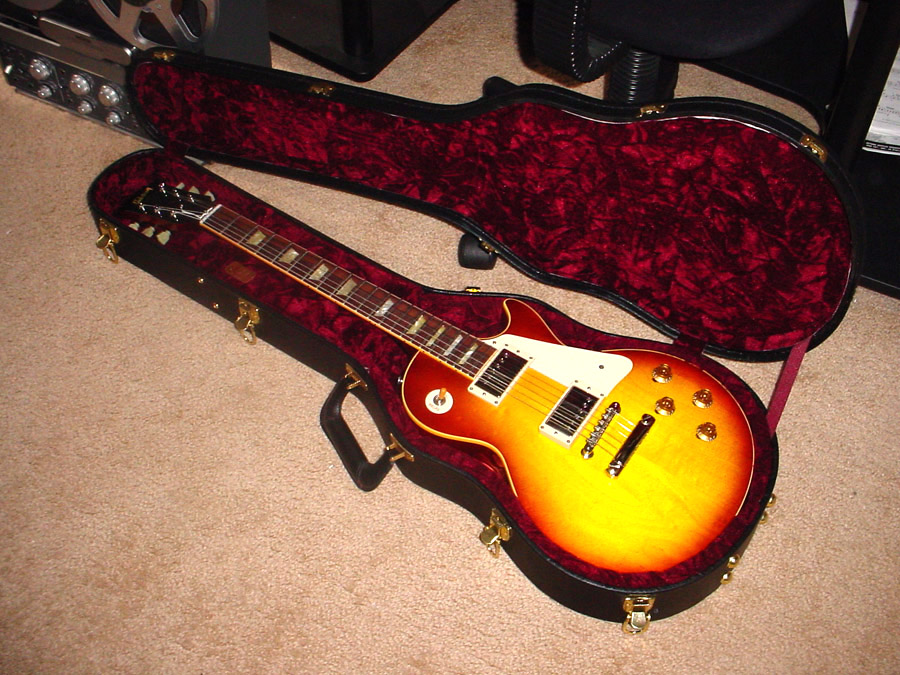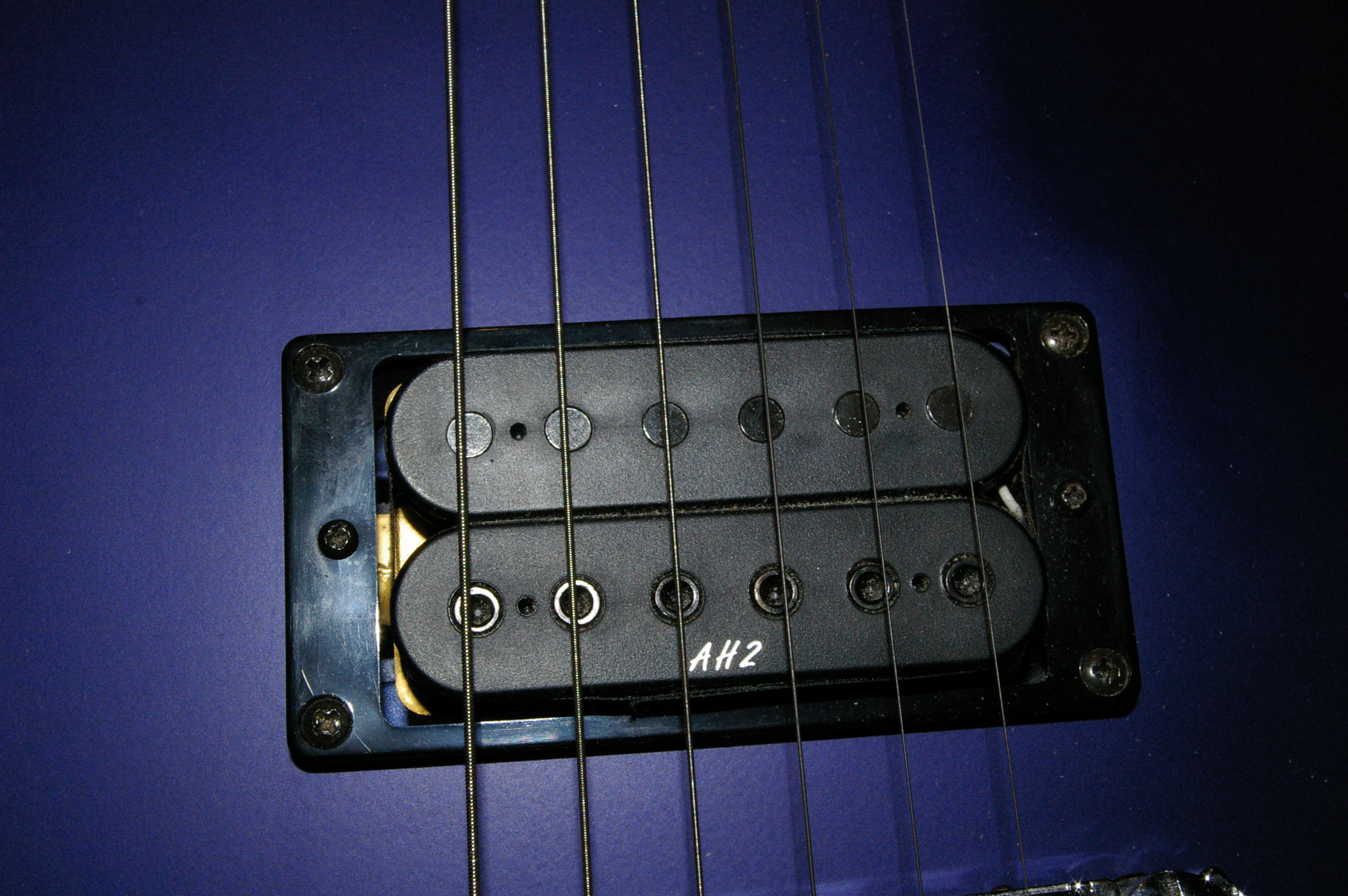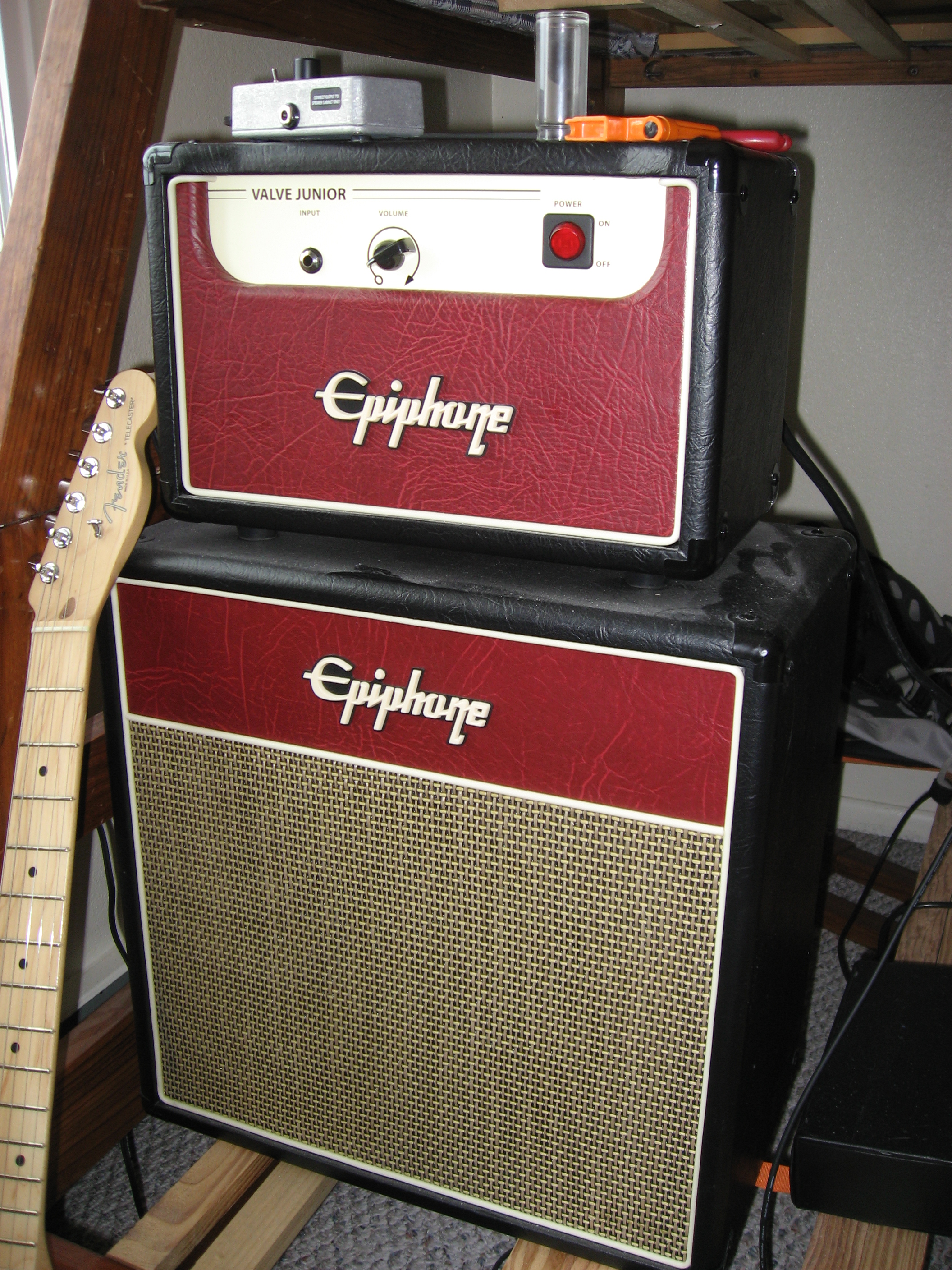|
Gibson SG
The Gibson SG is a solid-body electric guitar model introduced by Gibson in 1961 as the Gibson Les Paul SG. It remains in production today in many variations of the initial design. The SG (where "SG" refers to Solid-Body Guitar) Standard is Gibson's best-selling model of all time. Origins In 1960, Gibson Les Paul sales were significantly lower than in previous years. The following year, the flat-topped, mahogany bodied Les Paul design was given a thinner, more contoured body with a double cutaway. Not only did this make the upper frets more accessible, it was further eased by moving the neck joint outwards by three frets. The simpler body construction significantly reduced production costs, and the new Les Paul, with its slender neck profile and small heel where it joined the body, was advertised as having the "fastest neck in the world". However, the redesign was done without knowledge of Les Paul himself. Although the new guitar was popular, he strongly disliked it. Problems ... [...More Info...] [...Related Items...] OR: [Wikipedia] [Google] [Baidu] |
Gibson Les Paul
The Gibson Les Paul is a solid body electric guitar that was first sold by the Gibson Guitar Corporation in 1952. The guitar was designed by factory manager John Huis and his team with input from and endorsement by guitarist Les Paul. Its typical design features a solid mahogany body with a carved maple top and a single cutaway, a mahogany set-in neck with a rosewood fretboard, two pickups with independent volume and tone controls, and a stoptail bridge, although variants exist. The Les Paul was originally offered with a gold finish and two P-90 pickups. In 1957, humbucking pickups were added, along with sunburst finishes in 1958. The 1958–1960 sunburst Les Paul, today one of the best-known electric guitar types in the world, was considered a commercial failure, with low production and sales. For 1961, the Les Paul was redesigned into what is now known as the Gibson SG. The original single-cutaway, carved top bodystyle was re-introduced in 1968. The Les Paul has been produce ... [...More Info...] [...Related Items...] OR: [Wikipedia] [Google] [Baidu] |
Les Paul
Lester William Polsfuss (June 9, 1915 – August 12, 2009), known as Les Paul, was an American jazz, country, and blues guitarist, songwriter, luthier, and inventor. He was one of the pioneers of the solid-body electric guitar, and his prototype, called the Log, served as inspiration for the Gibson Les Paul. Paul taught himself how to play guitar, and while he is mainly known for jazz and popular music, he had an early career in country music. In the 1950s, he and his wife, singer and guitarist Mary Ford, recorded numerous records, selling millions of copies. Paul is credited with many recording innovations. His early experiments with overdubbing (also known as sound on sound), delay effects such as tape delay, phasing, and multitrack recording were among the first to attract widespread attention. His licks, trills, chording sequences, fretting techniques, and timing set him apart from his contemporaries and inspired many guitarists of the present day. Among his many honors, ... [...More Info...] [...Related Items...] OR: [Wikipedia] [Google] [Baidu] |
Gibson SG Special
The Gibson SG Special is an electric guitar made by Gibson that has been manufactured since 1961. Origins The SG Special was between the Junior and Standard model and was introduced concurrent with the Junior. It featured two P-90 pickups with either a stoptail bridge or an optional Vibrola. On this mid-level SG model, Gibson kept the neck binding but used dot inlays in place of the trapezoid position markers of the standard model and did not use the crown inlay on the headstock. With various minor changes (bridge and tailpiece replacing the stoptail in 1972, mini humbucker pickups between 1972 and 1976 and full sized open-coil humbuckers thereafter) the model has remained in continuous production. The influence of the P90-equipped SGs of the late 1960s and later reissues (such as the more recent SG classic—a modern reissue of the late 1960s SG Special) have spanned the rock genre and have notably been played by the likes of Pete Townshend (The Who: late-1960s SG Specials), To ... [...More Info...] [...Related Items...] OR: [Wikipedia] [Google] [Baidu] |
Pearloid
Pearloid is a plastic that is intended to resemble mother of pearl. It is commonly used in making musical instruments, especially for pickguards, electric guitar inlays, and accordions. Production Pearloid is produced by swirling together chunks of celluloid in a solvent, then curing, which gives it a mother of pearl effect. It is sliced and bonded to or inlaid in other materials, such as the wood of guitar necks. Use Pearloid is used in any context where genuine mother of pearl or abalone might be used, as it is much cheaper and doesn't deplete the supply of the natural material. Gibson uses it as a substitute for the mother of pearl inlays in the fretboards on most of its guitars. Various colored versions are often used on items intended to have a retro appearance. See also *Imitation pearl Imitation pearls are man-made ''faux'' pearls. They are not to be confused with cultured pearls, which are real pearls created through artificial intervention. Materials used to cre ... [...More Info...] [...Related Items...] OR: [Wikipedia] [Google] [Baidu] |
Gibson Vibrola
A vibrato system on a guitar is a mechanical device used to temporarily change the pitch of the strings. Instruments without a vibrato have other bridge and tailpiece systems. They add vibrato to the sound by changing the tension of the strings, typically at the bridge or tailpiece of an electric guitar using a controlling lever, which is alternately referred to as a whammy bar, vibrato bar, or incorrectly as a tremolo arm. The lever enables the player to quickly and temporarily vary the tension and sometimes length of the strings, changing the pitch to create a vibrato, portamento, or pitch bend effect. The pitch-bending effects have become an important part of many styles, allowing creation of sounds that could not be played without the device, such as the 1980s-era shred guitar " dive bomb" effect. The mechanical vibrato systems began as a device for more easily producing the vibrato effects that blues and jazz guitarists had achieved on arch top guitars by manipulating the ... [...More Info...] [...Related Items...] OR: [Wikipedia] [Google] [Baidu] |
Pickup (music Technology)
A pickup is a transducer that captures or senses mechanical vibrations produced by musical instruments, particularly stringed instruments such as the electric guitar, and converts these to an electrical signal that is amplified using an instrument amplifier to produce musical sounds through a loudspeaker in a speaker enclosure. The signal from a pickup can also be recorded directly. Most electric guitars and electric basses use magnetic pickups. Acoustic guitars, upright basses and fiddles often use a piezoelectric pickup. Magnetic pickups A typical magnetic pickup is a transducer (specifically a variable reluctance sensor) that consists of one or more permanent magnets (usually alnico or ferrite) wrapped with a coil of several thousand turns of fine enameled copper wire. The magnet creates a magnetic field which is focused by the pickup's pole piece or pieces. The permanent magnet in the pickup magnetizes the guitar string above it. This causes the string to generate a ma ... [...More Info...] [...Related Items...] OR: [Wikipedia] [Google] [Baidu] |
Humbucker
A humbucking pickup, humbucker, or double coil, is a type of guitar pickup that uses two wire coils to cancel out the noisy interference picked up by coil pickups. In addition to electric guitar pickups, humbucking coils are sometimes used in dynamic microphones to cancel electromagnetic hum. Humbuckers are one of the two main types of guitar pickup, the other being single coil. History The "humbucking coil" was invented in 1934 by Electro-Voice, an American professional audio company based in South Bend, Indiana that Al Kahn and Lou Burroughs incorporated in 1930 for the purpose of manufacturing portable public address equipment, including microphones and loudspeakers. The twin coiled guitar pickup invented by Arnold Lesti in 1935 is arranged as a humbucker, and the patent USRE20070 describes the noise cancellation and current summation principles of such a design. This "Electric Translating Device" employed the solenoid windings of the pickup to magnetize the steel strin ... [...More Info...] [...Related Items...] OR: [Wikipedia] [Google] [Baidu] |
Set-in Neck
A set-in neck (often shortened to ''set neck'') is the traditional form of joining the neck of a stringed instrument with its body. This is typically done with a tightly fitted mortise-and-tenon or dovetail joint, secured with hot hide glue. Among its qualities are a warm tone, long sustain, and a large surface area to transmit string vibration, leading to a "live" feeling instrument. In guitars it also often allows superior access to top frets closest to the body. It is a common belief that this yields a stronger body-to-neck connection than an inexpensive mechanically joined bolt-on neck, though some luthiers believe a well-executed bolt-on neck joint is equally strong and provides similar neck-to-body contact. However, neither of these joints is as strong as a neck-through construction, the third of the common methods of neck attachment, which requires more material and is usually found only on high-end solid body guitars. Set-in necks are the most popular on acoustic gu ... [...More Info...] [...Related Items...] OR: [Wikipedia] [Google] [Baidu] |
Fender Stratocaster
The Fender Stratocaster, colloquially known as the Strat, is a model of electric guitar designed from 1952 into 1954 by Leo Fender, Bill Carson, George Fullerton, and Freddie Tavares. The Fender Musical Instruments Corporation has continuously manufactured the Stratocaster since 1954. It is a double- cutaway guitar, with an extended top "horn" shape for balance. Along with the Gibson Les Paul, Gibson SG, and Fender Telecaster, it is one of the most-often emulated electric guitar shapes. "Stratocaster" and "Strat" are trademark terms belonging to Fender. Guitars that duplicate the Stratocaster by other manufacturers are sometimes called ''S-Type'' or ''ST-type'' guitars. The guitar introduced into the popular market several features that were innovative for electric guitars in the mid-1950s. The distinctive body shape, which has become commonplace among electric guitars, was revolutionary for the time period, and for the first time a mass-market electric guitar did not significan ... [...More Info...] [...Related Items...] OR: [Wikipedia] [Google] [Baidu] |
Epiphone
Epiphone is an American musical instrument brand that traces its roots to a musical instrument manufacturing business founded in 1873 by Anastasios Stathopoulos in Smyrna, Ottoman Empire, and moved to New York City in 1908. After taking over his father's business, Epaminondas Stathopoulos named the company "Epiphone" as a combination of his own nickname "Epi" and the suffix " -phone" (from Greek ''phon-'', "voice") in 1928, the same year it began making guitars. In 1957 Epiphone, Inc. was purchased by Gibson, its main rival in the archtop guitar market at the time. Gibson relocated Epiphone's manufacturing operation from its original Queens, New York, factory to Gibson's Kalamazoo, Michigan, factory. Over time, as Gibson moved its own manufacturing operations to other facilities, Epiphone followed suit; Gibson has also subcontracted the construction of Epiphone products to various facilities in the US and internationally. Today, Epiphone is still used as a brand for the Gibson com ... [...More Info...] [...Related Items...] OR: [Wikipedia] [Google] [Baidu] |
Gibson Kalamazoo
Kalamazoo is the name for two different lines of instruments produced by Gibson. In both cases Kalamazoo was a budget brand. The first consisted of such instruments as archtop, flat top and lap steel guitars, banjos, and mandolins made between 1933 and 1942, and the second, from 1965 to 1970, had solid-body electric and bass guitars. First series The first line of instruments included guitars with bodies between 14" and 16", which in 2009 were worth up to $1800. Second series The name was revived during the guitar boom of the late 1960s; at the time, guitar manufacturers "could sell just about anything they could make or lay their hands on". Gibson already had the Epiphone brand which it used to market more affordable guitars, but Epiphone was already a mid-level brand and Gibson desired something truly cheap. The Kalamazoo brand, whose guitars had bolt-on necks, filled that slot. "USA" was added to the name on the headstock to set it apart from cheaper, imported guitars. Whil ... [...More Info...] [...Related Items...] OR: [Wikipedia] [Google] [Baidu] |
.jpg)


.png)





